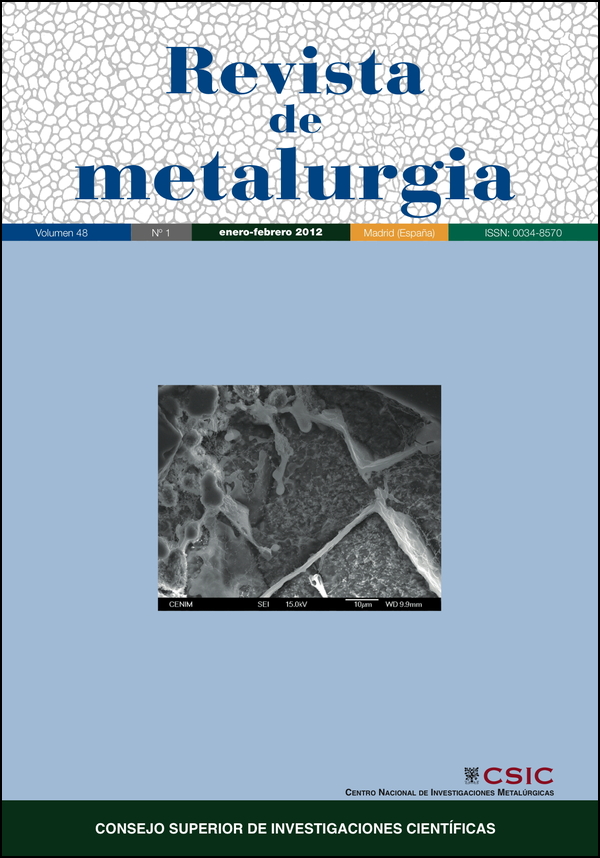Characterization of solid wastes from two different hot-dip galvanizing processes
DOI:
https://doi.org/10.3989/revmetalm.1131Keywords:
haracterization, Wastes, Hot-dip galvanizing, Zinc ash, Zinc dustAbstract
Zinc dust and zinc ash from hot-dip galvanizing industries located in Venezuela were characterized using atomic spectroscopy, scanning electron microscopy, X-Ray diffraction and infrared spectroscopy. Dust was formed during the high-pressure drying process of the galvanized pieces, in a plant that uses a steel kettle to hold the molten zinc. Ash identified as “A” came from the same plant as the dust, while ash identified as “B” came from a hot-dip galvanizing plant which use a ceramic lined galvanizing furnace. Dust contained 98 wt % Zn, in metallic form. Both ash samples contained: Zn and ZnO, while Zn5(OH)8Cl2—H2O and ZnCl2 were only found in ash “B”. Globally, ash “A” and ash “B” contain 71 and 75 wt % Zn, respectively.
Downloads
References
[1] N. Durán, Tesis de Licenciatura en Ingeniería de Materiales, Departamento de Ciencias de los Materiales, Universidad Simón Bolívar, 2010.
[2] X. Castells, Reciclaje de Residuos Industriales, Ed. Díaz de Santos S. A., Madrid, España, 2000, pp. 1-2, 15-18, 27-29, 45-48.
[3] C. Escudero, Tesis Doctoral, Departament d’Enginyeria Química, Agrària i Tecnologia Agroalimentaria, Universitat de Girona, 2009.
[4] L. Korb y D. Olson, Corrosion, ASM Handbook, Volume 13, ASM International, 4ta. Edición, EE.UU., 1992, pp. 959-974.
[5] N. Birks, G.Meier y F. Petit, Introduction to High-Temperature Oxidation of Metals, Cambridge University Press, 2da. Edición, Inglaterra, 2006, pp. 23.
[6] B. H. Stuart, Infrared Spectroscopy: Fundamentals and Applications, John Wiley & Sons Ltd., Chichester, Inglaterra, 2004, pp. 26-27, 96-99.
[7] M. Saheer, M. Alam, M. Seok Jon y O. Yang, Electrochim. Acta 53 (2008) 7869-7874. http://dx.doi.org/10.1016/j.electacta.2008.05.055
[8] M. Yeganeh, J. Alloy Compd. 491 (2010) 420-422.
[9] B. M. Keyes, L. M. Gedvilas, X. Li y T. J. Coutts, J. Cryst. Growth 281 (2005) 297-302. http://dx.doi.org/10.1016/j.jcrysgro.2005.04.053
[10] C. Pholnak, C. Sirisathitkul y D. J. Harding, J. Phys. Chem. Solids. 72 (2011) 817-823. http://dx.doi.org/10.1016/j.jpcs.2011.04.005
[11] O. Kammori, N. Yamaguchi y K. Sato, Jpn. Analyst. 16 -10 (1967)1.050-1.055.
[12] G. Zhang, S. Yu, Y. Yang, W. Jiang, S. Zhang y B. Huang, J. Cryst. Growth 312 (2010) 1.866-1.871.
[13] P. Navarro, C. Vargas, R. Álvarez y F. J. Alguacil, Rev. Metal. Madrid 41 (2005) 12-20.
[14] J. O. Nriagu, Zinc in the environment. Part I: Ecological Cycling, John Wiley & Sons Ltd., Burlington, Canadá, 1980, pp. 4, 33-35, 39-45, 52-57, 337-343, 347-349.
[15] I. Cakmak, J. Trace. Elem. Med. Bio, 23 (2009) 281-289. http://dx.doi.org/10.1016/j.jtemb.2009.05.002 PMid:19747624
[16] M. Salgueiro, M. Zubillaga, A. Lysionek, M. Sarabia, R. Caro, T. De Paoli, A. Hager, E. Ettlin, R. Weill y J. Boccio, Nutrition 16-9 (2000) 762-766. http://dx.doi.org/10.1016/S0899-9007(00)00379-8
Downloads
Published
How to Cite
Issue
Section
License
Copyright (c) 2012 Consejo Superior de Investigaciones Científicas (CSIC)

This work is licensed under a Creative Commons Attribution 4.0 International License.
© CSIC. Manuscripts published in both the printed and online versions of this Journal are the property of Consejo Superior de Investigaciones Científicas, and quoting this source is a requirement for any partial or full reproduction.All contents of this electronic edition, except where otherwise noted, are distributed under a “Creative Commons Attribution 4.0 International” (CC BY 4.0) License. You may read here the basic information and the legal text of the license. The indication of the CC BY 4.0 License must be expressly stated in this way when necessary.
Self-archiving in repositories, personal webpages or similar, of any version other than the published by the Editor, is not allowed.


















